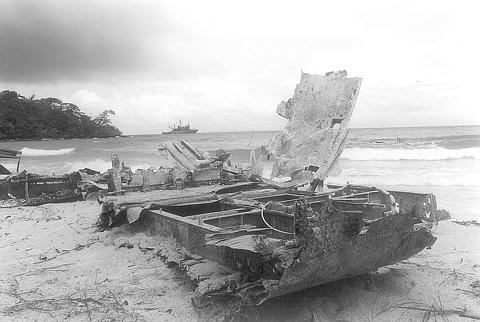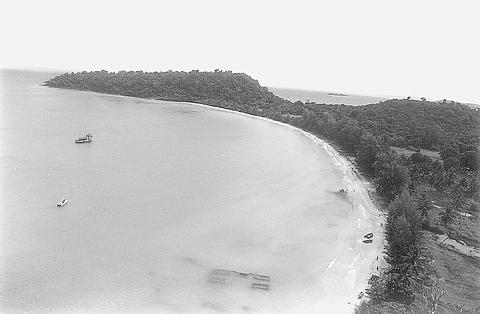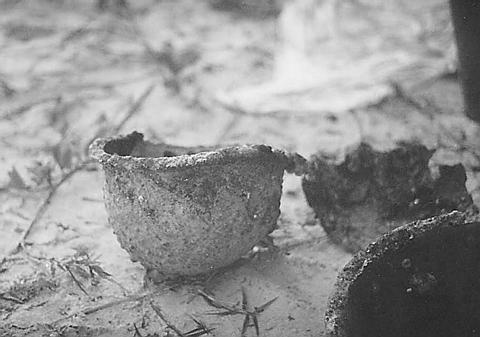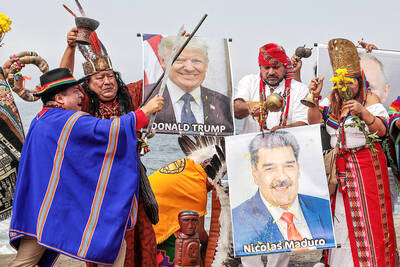The otherwise routine voyage of the Sealand container ship Maya-guez to the Thai port of Sattahip was brought to an abrupt halt on the afternoon of May 12, 1975? by a pair of Khmer Rouge patrol boats and their heavily-armed crews.
Accused of violating Cambodian territorial waters, the ship and its 39 member crew were diverted toward the nearby island of Koh Tang.
Coming just 12 days after America's humiliating retreat from Vietnam, the hostage-taking became the focus of American government efforts to salvage a superpower reputation tarnished by the recent twin Communist victories in Cambodia and Vietnam.

PHOTO: DAVID VAN DER VEEN
"The National Security Council was convened and [then-US Secretary of State] Kissinger argued that much more was at stake than the seizure of an American ship ... [that] American credibility was more involved than ever," the British journalist William Shawcross wrote in his 1979 book Sideshow: Nixon, Kissinger and the Destruction of Cambodia. "Throughout the crisis the Secretary insisted that for domestic and international reasons, and particularly to impress the North Koreans, the US must use force."
Although the Mayaguez crew was transferred by fishing boat to the port of Sihanoukville on the afternoon of May 13, American military intelligence believed that at least half the crew remained on Koh Tang and plans were laid for a rescue attempt by American Marines based in Thailand.
The plan went quickly wrong.

PHOTO: DAVID VAN DER VEEN
The KR vessel carrying the Mayageuz crew to Sihanoukville was repeatedly strafed and tear-gassed by American planes unsuccessfully seeking to force the craft back to Koh Tang.
A group of the Mayaguez crew later unsuccessfully tried suing the US government for chronic health problems incurred as a result of those aerial attacks.
On the evening of May 14, 23 US servicemen became the Mayaguez Incident's first fatalities after their helicopter crashed en route from Thailand's Nakhon Phanom airbase to the operation's departure point of U Tapao air base.

PHOTO: RALPH WETTERHAHN
A US government memorial unveiled in Phnom Penh in 1995 by visiting American Senator John McCain makes no mention of those men.
At dawn on May 15, 170 Marines in eight Knife and Jolly Green Giant helicopters approached Koh Tang in the first stage of a rescue attempt in which little or no resistance was expected from what American military intelligence had described as an opposition force of 35-40 KR "irregulars."
Instead, they entered a firestorm orchestrated by a well-armed and well dug-in platoon of battle-hardened veterans of the April 17 "liberation" of Phnom Penh, who brought their newly-acquired American guns and ammunition confiscated from losing Lon Nol forces to bear on the invading force.
Within minutes, three helicopters had been shot down and for the next 24 hours US forces fought for their lives in a battle that eventually killed 16 KR combatants and additional 18 American servicemen, their remains the focus of intensive searches by US government MIA retrieval teams on Koh Tang that continue to this day.
In a bitter irony unknown to the Marines on Koh Tang until after their harrowing escape back to the US aircraft carrier Coral Sea on the morning of May 16, the crew of the Mayageuz had been released by their captors onto a Thai fishing boat several hours before the attack had commenced.
At 10:08am on May 15, while US helicopter gunships perforated with small arms fire struggled to land reinforcements and evacuate wounded personnel from Koh Tang, the crew of the Mayaguez was picked up by the US navy in the Gulf of Thailand.
As Shawcross noted in Sideshow, US President Ford was quick to describe the Mayaguez mission as a success in that "...it did not only ignite confidence in the White House ... it had an electrifying reaction as far as the American people were concerned. It was a spark that set off a whole new sense of confidence for them, too."
Calculating the costs of the battle -- 41 dead servicemen in return for the safe return of 39 American seamen and the loss of life and property of Cambodians unaware of their position in American foreign and domestic policy objectives, Shawcross is unequivocal in his condemnation of Ford's upbeat assessment of the results of the Mayageuz Incident.
"In the attacks on [Sihanoukville] the railroad yard, the port, the oil refinery and the airfield were virtually destroyed. At Ream naval base, 364 buildings were flattened. Nine Cambodian vessels were sunk at sea. In order to rescue the Marines on Koh Tang, the island was heavily bombarded ... [ignoring] the August 1973 ban on bombing Indochina as well as the 1973 War Powers Act. The principal purpose of the bombing seem to have been to punish the Cambodians and to reassert a concept of American bellicosity, which the collapse of Phnom Penh and Saigon was seen to have damaged."
Even more disturbingly, the battalion commander of the Khmer Rouge forces on Koh Tang admitted during an interview with the Taipei Times last week that, contrary to long held Pentagon assertions to the contrary, American servicemen had been abandoned on Koh Tang during the confusion of their withdrawal.
"Ten days after the American soldiers left Koh Tang, a tree-cutting detail sighted a figure taking water from a well," Mao Run told the Taipei Times. "When they investigated, they found boot marks which we knew had to belong to an American soldier because our men only wore sandals."
According to Run, the abandoned American Marine was found and executed shortly after.
Run's admission 25 years after the fact adds credence to the belief held by many Marines who participated in the Koh Tang operation of a "lost machine-gun team" inadvertently left behind on the island.?
"We were told on the US Coral Sea that a machine-gun team was killed by the KR as we withdrew from the island, but years later I suspect that they were left behind," Koh Tang marine veteran Dale L. Clark told the Taipei Times. "I believe the US government knew the team was alive on the island because I heard and saw preparations made on the USS Coral Sea to return to the island, [but] no attempts were made to travel back to the island for their recovery ... I suspect the US government canceled the plans not wanting to have any more Marines killed during the recovery."
Lieutenant Colonel Franklin Childress, Public Affairs Officer of the Joint Task Force for Full Accounting for MIAs in Hawaii was unaware of Run's allegations, but assured the Taipei Times that MIA investigators were still pursuing rumors that US Marines had been left behind on Koh Tang.
"The case of the three-man machine-gun team is still under investigation," Childress said.? "There are still places to investigate and places to be excavated [for MIA remains on Koh Tang]."

Shamans in Peru on Monday gathered for an annual New Year’s ritual where they made predictions for the year to come, including illness for US President Donald Trump and the downfall of Venezuelan President Nicolas Maduro. “The United States should prepare itself because Donald Trump will fall seriously ill,” Juan de Dios Garcia proclaimed as he gathered with other shamans on a beach in southern Lima, dressed in traditional Andean ponchos and headdresses, and sprinkling flowers on the sand. The shamans carried large posters of world leaders, over which they crossed swords and burned incense, some of which they stomped on. In this

‘NO COUNTRY BUMPKIN’: The judge rejected arguments that former prime minister Najib Razak was an unwitting victim, saying Najib took steps to protect his position Imprisoned former Malaysian prime minister Najib Razak was yesterday convicted, following a corruption trial tied to multibillion-dollar looting of the 1Malaysia Development Berhad (1MDB) state investment fund. The nation’s high court found Najib, 72, guilty on four counts of abuse of power and 21 charges of money laundering related to more than US$700 million channeled into his personal bank accounts from the 1MDB fund. Najib denied any wrongdoing, and maintained the funds were a political donation from Saudi Arabia and that he had been misled by rogue financiers led by businessman Low Taek Jho. Low, thought to be the scandal’s mastermind, remains

Near the entrance to the Panama Canal, a monument to China’s contributions to the interoceanic waterway was torn down on Saturday night by order of local authorities. The move comes as US President Donald Trump has made threats in the past few months to retake control of the canal, claiming Beijing has too much influence in its operations. In a surprising move that has been criticized by leaders in Panama and China, the mayor’s office of the locality of Arraijan ordered the demolition of the monument built in 2004 to symbolize friendship between the countries. The mayor’s office said in

FIGHTING CONTINUES: Thai military dropped 40 bombs on border areas, Cambodia said, while Bangkok said Phnom Penh launched heavy attacks and damaged homes Cambodia yesterday accused Thailand of intensifying its bombardment of disputed border areas, even as officials from the two countries attend a multi-day meeting aimed at negotiating an end to deadly clashes. The neighbors’ long-standing border conflict reignited this month, shattering an earlier truce and killing more than 40 people, according to official counts. About 1 million people have also been displaced. Cambodian and Thai officials were in their third day of talks at a border checkpoint, with ministers of defense from the two countries scheduled to meet today. However, the Cambodian Ministry of National Defense said Thailand’s military carried out a heavy